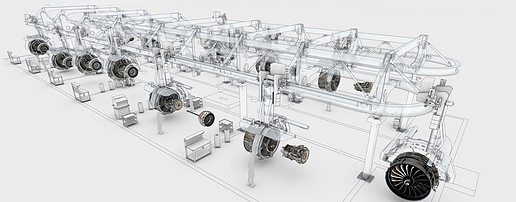 发动机的位置变换将由触屏和一个Snecma专利的高空装卸系统进行管理,该系统有一个类似于“旋转摇篮”的装置,可将发动机沿着水平轴转动,这样员工就不用在高空进行作业了。
发动机的位置变换将由触屏和一个Snecma专利的高空装卸系统进行管理,该系统有一个类似于“旋转摇篮”的装置,可将发动机沿着水平轴转动,这样员工就不用在高空进行作业了。 发动机部件和次级装配件的定位工作将采用最新的激光投射和虚拟现实辅助系统完成,此外操作员还能使用通过网络进行互联的工具和其他先进设备。此外这些装配线还设计了操作员反馈功能,并可根据建议进行调整。
发动机部件和次级装配件的定位工作将采用最新的激光投射和虚拟现实辅助系统完成,此外操作员还能使用通过网络进行互联的工具和其他先进设备。此外这些装配线还设计了操作员反馈功能,并可根据建议进行调整。
在最近举行的巴黎航空展上,法国发动机制造商Snecma宣布将投资建设一家全新的装配厂,以满足新型LEAP发动机前所未有的客户需求量。LEAP发动机是Snecma与通用电气组建的合资公司CFM的产品之一,将用于采用新型发动机的最新版波音737、空客A320系列和中国商飞C919机型。
在该消息宣布之际,这款新发动机已确认和已承诺订购的订单量已经超过8900份,在巴黎航空展上又新增了500多份订单,而一年后这些数量庞大的订单就要变成真实的产品,开始服役了。
尽管还在研发阶段,但新LEAP发动机已成为航空史上最畅销的发动机。因此,制造商和整个供应链所面临的挑战,就是如何生产出足够的发动机,以满足1.2万多架新飞机的庞大需求。
波音和空客的月产量接近50架飞机,这个数字还将继续上升。由CFM和Pratt & Whitney生产的新一代发动机将会让这些150座飞机变成人气宠儿,它们将是生产任务的重中之重,而其中LEAP发动机的生产尤其关键,因为这是737 Max系列唯一采用的发动机。
因此,Snecma正在努力发展供应链,为前所未有的生产需求匹配所需的产能。
作为LEAP前身的CFM56发动机在十多年间产量得到了逐渐增加,最后达到年产近1600台的水平。但LEAP所面临的挑战则艰巨得多,因为它必须在短短4年内,也就是到2020年将产量增至1800台以上。该合资公司的美国和法国出资方对分工有所约定,根据这一约定,CMF所生产的全部发动机中,有一半将由Snecma负责进行最后总装,装配地点为位于巴黎附近的Snecma Villaroche工厂。
为了应对这一巨大挑战,除了现有的CFM56生产线外,Snecma还将建造两条专属于LEAP的全新装配线。新生产线长60米,宽20米,每条装配线的年产量为500台发动机。每条生产线都能装配LEAP的三种版本——空客A320neo的LEAP-1A、波音737 MAX的LEAP-1B,以及中国商飞C919的LEAP-1C。这两条装配线将分别于2017年1月和2018年初建设完毕并启动运行,届时Snecma的Villaroche工厂将具备年产1000台发动机的能力,相当于每天可完成4台发动机的生产。
现有的两条CFM56装配线从2009年开始服役,至今已为Snecma节约了30%的装配时间,而全新的两条LEAP装配线将采用一系列创新技术,继续保持这一优势。
比如说,发动机的位置移动将由触屏和一个Snecma拥有专利的高空装卸系统进行管理,该系统配有一个类似于“旋转摇篮”的装置,可将发动机沿着水平轴转动,这样员工就不用在高空进行作业了。发动机部件和次级装配件的定位工作将采用最新的激光投射和虚拟现实辅助系统,此外操作员还能使用通过网络进行互联的工具,以及其他先进设备。
这些装配线还设计了操作员反馈功能,并可根据建议进行调整,可以显著提升整个生产线和装配线上各工位操作员的舒适度和工作效率。此外,这两条全新的装配线也为未来可能需要增加的产能保留了调整的空间。CFM的合作伙伴通用电气公司也将在其位于美国印第安纳州西拉斐特的工厂进行LEAP发动机的产能扩大工作,其中一条生产线今年年底即可投入使用。
New pulse lines for LEAP engine production
During the recent Paris Air Show, French engine manufacturer Snecma announced significant investment in a new assembly facility to meet the unprecedented level of customer demand for the new LEAP engine, which is being developed as part of the CFM partnership with GE to power the latest re-engined versions of the Boeing737 and Airbus A320 families and the new Chinese COMAC 919 airliner.
At the time of the announcement, before another flood of 500+ orders were declared at Paris, there were already more than 8900 orders and commitments for the new engine, a year before entry into service.
The new LEAP is already the world’s best-selling new engine, while it is still under development, in the history of aviation. The challenge facing the engine manufacturers, and everyone else down through the supply chain, is how to produce enough units to satisfy what has grown to a backlog of well over 12,000 new aircraft.
Even with aircraft output at Boeing and Airbus heading toward 50 airframes every month, and possibly rising even higher, the need to supply the new generation engines (from CFM and Pratt & Whitney) that is making these 150-seat airplanes so popular has become a priority, certainly in the case of the LEAP engine, which is the sole source powerplant on the 737 Max family.
As a result, Snecma is preparing its supply chain and industrial capabilities for an unprecedented production ramp-up.
The LEAP's predecessor, the CFM56, saw its production gradually rise over a dozen years to an annual rate of nearly 1600 engines. The LEAP faces a much more daunting challenge, since it is aiming at an annual production rate of more than 1800 engines as early as 2020, in just four years. In line with the assigned workshares in the joint French/U.S. company, Snecma is responsible for the final assembly of half of all engines made by CFM, with this assembly being handled by Snecma's Villaroche plant near Paris.
To meet this huge challenge, Snecma is to build two new assembly lines dedicated to the LEAP, alongside the two existing CFM56 production lines. These new pulse lines will stretch 60 m long and 20 m wide (about 200 x 65 ft), and each line will offer a capacity up to 500 engines per year. They will be able to assemble all three versions of the LEAP: the LEAP-1A for the Airbus A320neo, the LEAP-1B for the Boeing 737 MAX, and the LEAP-1C for the Comac C919. These two lines will be up and running by January 2017 and early 2018, allowing Snecma to assemble up to 1000 engines/year at Villaroche—the equivalent to over four engines every day.
The two current CFM56 pulse lines, commissioned in 2009, had already enabled Snecma to reduce engine assembly time by 30% and the two new LEAP assembly lines will extend this initiative, while adding a number of innovations.
For example, engine movements will be managed by touchscreens, and an overhead handling system featuring a "swing cradle" that enables rotating the engine around the horizontal axis (a proprietary Snecma process), so staff won't have to work at heights. The positioning of components and subassemblies on the engine will use the latest laser projection and virtual reality assistance systems, while operators will use connected tools and other advanced devices.
The design of these pulse lines involves operator feedback and can accommodate recommendations. It is expected that this will significantly enhance the comfort and efficiency of operators at the various workstations throughout the production and assembly process. The new additions to the plant will allow for a third LEAP assembly line if this is eventually needed to increase production capacity even further. The GE partners in CFM are also expanding their own LEAP production facilities in the U.S. at West Lafayette, IN, which will see a new line open before the end of this year.
等级
打分
- 2分
- 4分
- 6分
- 8分
- 10分
平均分
